
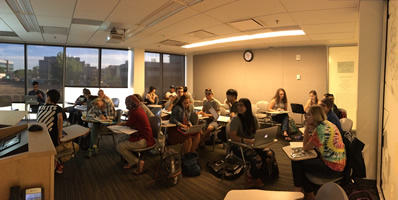
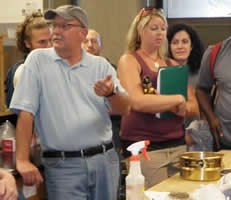
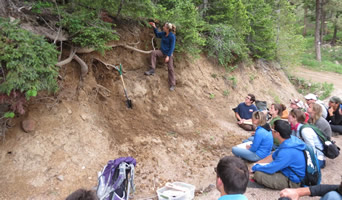
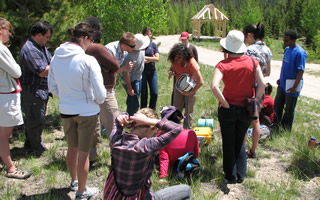
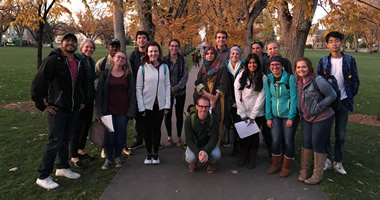

NESB Conference Rooms, Zoom, Teams
This page has information on NESB meeting rooms, Zoom & Teams video conferencing, and video conferencing best practices.
Natural and Environmental Sciences Building (NESB) meeting rooms
The following meeting and conference rooms are available. Below is a short video of how to schedule a NESB conference room in Outlook. How to schedule NESB conference room video
David Swift Conference Room “The Trailhead” (NESB B218)
Capacity: 36 +/- people (classroom style but can be rearranged)
Usage: Generally intended for larger meetings, video meetings
Technology: 110” LED video wall with HDMI, VGA (wall and floor) inputs, in-room Windows computer, camera for speaker and audience;
Outlook calendar resource: NREL NESB B218 Swift Conf Room
Francis Clark Conference Room (NESB B215)
Capacity: 10-20 people (conference room style)
Usage: Generally intended for medium group meetings, video meetings
Technology: 82” LED video screen with HDMI inputs, Owl group camera.
Outlook calendar resource: NREL NESB B215 Clark Conf Room
NREL NESB A319 (NESB A319)
Capacity: 6-10 people (conference room style)
Usage: Generally intended for small group meetings, video meetings
Technology: 70” LED video screen with HDMI & VGA inputs, in-room Windows computer, Owl group camera.
Outlook calendar resource: NREL NESB A319 Conf Room
NREL NESB A105c (NESB A105c)
Capacity: 4-8 people (central table)
Usage: In the grad student office used for small meetings and TA office hours
Technology: none yet, but soon to have a 65″ LED video screen and camera available
Outlook calendar resource: NREL NESB A105c Conf Room
NREL NESB B245 (NESB B245)
Capacity: 2-4 people (desks)
Usage: student meetings, TA office hours
Technology: none
Outlook calendar resource: NREL NESB B245
NREL NESB B247 (NESB B247)
Capacity: 2-4 people (desks)
Usage: student meetings, TA office hours
Technology: none
Outlook calendar resource: NREL NESB B247
Microsoft Teams
Microsoft Teams is a communication platform, and collaboration platform as well. You do not need a “Team” to be able to use the communication (have a meeting) with teams.
ACNS has some good info about Teams including: how to create a team meeting, recording on teams, sharing/post a Teams recording to Canvas, holding office hours with a Teams meeting. https://www.acns.colostate.edu/microsoft-teams/
Other good basic information about MS Teams from CSU’s Microsoft help site. http://help.mail.colostate.edu/office365teams.aspx
Microsoft Teams training videos, articles. Click on the “Resources” link at the top of the page. https://products.office.com/en-us/microsoft-teams/group-chat-software
Teams info for students https://www.acns.colostate.edu/Microsoft-Teams-Students/
When do I need a “Team”: A team is a very helpful tool when you consistently work with a group of people, such as a lab group. It will keep a record of your communications. This can help with the “lost” email problem. Where your group email communications can get lost in the multitude that we receive every day. My recommendation is if your group decides to use teams make that your main means of communication for your group. Otherwise, it can be hard to remember if it is an email or Teams communication… I already have that issue myself.
How do I create a Team: You can not create a Team yourself, you will need to contact a Microsoft resource coordinator. Ty and Jonathan are resource coordinators. They will then create a team for you an make you the Team administrator. You can then invite anyone on campus to your Team.
How do I use MS Teams for communication: You can start a Teams app or login to the online version in the Office365 portal (see below for installing the app or finding the portal login). Click on the “Calls” icon on the right side of the screen. Then just below the “Make a call” link lookup whomever you want to call. You should be able to look up anyone on campus. If they have a green dot (status) they are available…. If the dot is yellow or red (status) they may not be available.
How much does Teams cost to use: Teams is included in University-wide Microsoft Office365 license, so is available to everyone on campus to use.
How do I use Teams with someone not on campus: As a guest…. from microsoft: “A team owner in Microsoft Teams can add and manage guests in their teams via the web or desktop. Anyone with a business or consumer email account, such as Outlook, Gmail, or others, can participate as a guest in Teams, with full access to team chats, meetings, and files. Only people who are outside of your organization, such as partners or consultants, can be added as guests. People from within your organization can join as regular team members.” https://docs.microsoft.com/en-us/microsoftteams/guest-joins
How do I get Teams on my computer: For your desktop go to Microsoft site and download the Teams installation. https://products.office.com/en-us/microsoft-teams/download-app
On your phone download it from your app store (Google Play, or iTunes). Your user name will be “username@colostate.edu” with your eID password.
Can I use Teams from a browser: Yes login to the Office365 portal https://portal.offfice.com and start the Teams app from there https://portal.office.com
TEAMS HINTS/ISSUES
Office documents can suddenly no longer be edited directly in the Teams desktop app. Apparently, Microsoft made this change intentionally for educational licenses (temporarily) due to the sudden high volume of Teams usage. To get around this limitation, you can use Teams on the web at teams.office.com, where it works as it used to. Hopefully they will change this back soon.
Zoom
Zoom is one of the best options for video-conferencing. It is intuitive to use and has many options for customizing conferences and recording. It is easy for participants to load the software and get to meetings. In Zoom even though you can setup multiple meeting times a, there can only be one meeting happening per license at a time. You can use teams in two ways: one with a personal Zoom account; second using the departmental Zoom license. If you do decide to record a Zoom meeting we recommend that you setup your meeting to automatically record it the the Zoom cloud (this is a setting you can choose when you setup the meeting). If you record any Zoom meeting to your local computer be aware that it can take a long time after the meeting to process the video on your local computer.
- Free Zoom Personal Account- Anyone can sign up for a Free personal Zoom license at https://zoom.us These licenses allow unlimited time 1 to 1 video conferences. Groups of 3 or more are limited to 40 minutes.
- Department Zoom license For larger work related meetings involving 3 or more participants see out internal resources website https://www2.nrel.colostate.edu/internal/conferencing.html
Video Conference Best Pratices
- Have a meeting manager. Keep the meeting moving and end on time.
- In general, don’t post links to meetings on websites or social media unless you can control the participants attending.
- Get all participants involved in the meeting.
- Send meeting agenda and materials ahead of time. It starts participants thinking about issues ahead of time. And have an end goal for the meeting. Is it status update, resolving and issues, long term project.
- Keeping meetings consistent. Especially for reoccurring meetings.
- Start at the same time and day of the week.
- Use a template for meeting announcements. That way people aren’t searching for meeting links.
- Create a summary of action items (and whom they are assigned to) immediately after the meeting.
- Document your meetings. Keep a folder with agendas and action items and share this with the group. This will help you not rehash the same issues and be more productive.
- Make sure your background isn’t distracting or overly backlit. If possible have the lighting be in front of the camera or above. Experiment with some different lighting.
- Get a good camera. Some laptop cameras are not the best. A logitech c920 is very good and can be found for $60-$70.
- Use a decent quality headset or microphone. The logitech c920 camera has good built microphone. If you can use a headset. Headsets will put the microphone in front of your face so your volume will be consistent.
- If you can’t hear or be heard well go into your settings and try adjusting those.
- Keep slides to 7 lines and use large fonts.
- If possible end the meeting early.